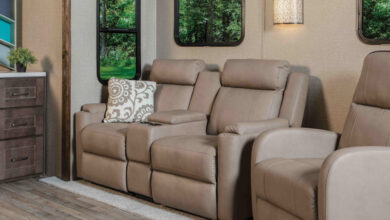Spring is almost here! Unfortunately, so are the pests. No place is immune to pests, and being closer to nature makes RVs more susceptible to infestations.
As a pest prevention expert and CEO and founder of plant-based pest control company, EarthKind, it’s my job to educate and share better alternatives for pest control. As we prepare for seasonal change, what can RV owners and professionals expect from pests?
First, consider the geographic region and weather patterns. Shorter winters, warmer weather, and heavier rainfalls mean longer breeding periods, earlier emergence of pests from their overwintering state, and the migration of pests, like ticks, to new geographic locations.
Here’s a breakdown of pests by region:
- Southeast: Drywood termites, rodents, Turkestan cockroach, lone star tick, acrobat ants, fire ants, blacklegged tick, wolf spider, and southern house spider.
- Southwest: Drywood termites; odorous house ant; Argentine ants; black widow spider; Turkestan, German, American and oriental cockroaches, house mouse, Norway rat, wood rat, scorpions, and Rocky Mountain wood tick.
- Northeast: Termites, black ants, pavement ants, carpenter ants, German cockroach, flies, larder beetles, Norway rat, blacklegged tick, wolf spiders, and American house spiders.
- Northwest: Termites, odorous ants, carpenter ants, Norway rat, hobo spider, western black widow spider, and western blacklegged ticks.
There’s some overlap here, but different pest species are attracted to different items and places in the RV. For example, Subterranean termites need protection from temperatures and build “shelter tubes” behind sheetrock and insulation in your RV, while Drywood termites will appear in wooden furnishings, like your RV’s subflooring.
Odorous ants are strongly attracted to sugary substances and are often found atop kitchen counters, whereas carpenter ants are larger, wood damaging insects. German cockroaches frequent kitchens and come through cracks in the wall, while oriental cockroaches are attracted to moisture, and will swim through pipes, emerging from drains. Ticks vary in the diseases they are likely to transmit.
As a leader in natural pest control, I believe prevention is always better than poisons. Here are DIY ways to pest-proof your RVs this spring:
- Do an inspection for cracks in walls, windows, doors, around plumbing and electrical wires. Seal them with caulk or weather-strip to keep pests (especially mice) out.
- Fix leaks. Dripping faucets or moisture indoors will attract spiders, ants, and cockroaches.
- Transfer dry foods into airtight glass, metal or plastic containers to protect them from mice, weevils, moths and small beetles.
- Cover or close drains after use to prevent drain flies, silverfish, cockroaches, and water bugs from coming up the pipes.
- Leave out lemon, lime and orange peels in the kitchen. Citrus peels are toxic to the fungi that ants feed on, and act as a natural repellent.
- Spray the insides of drawers with a vinegar-based cleaner, then wash them with a warm soap solution.
- Use a CDC-recommended repellent that’s effective for mosquitoes and ticks, like Picaridin. It’s the active ingredient in Stay Away Mosquitoes repellent because it lasts 14-hours, is unscented, skin-friendly and protects against mosquitoes, ticks, black flies, gnats and chiggers.
- Replace traps and poisons with plant-based repellents like EarthKind’s Fresh Cab, Botanical Rodent Repellent or EarthKind’s Stay Away Rodents, Spiders, Ants, and Moth pouches. Guaranteed effective, they’re safe for use around children and pets when used as directed.
Got it! But which pest is the biggest risk to RVs this year?
Weather is the ultimate predictor, but rodents cause the most damage in RVs, gnawing through fixtures, furnishings and electrical wiring. It’s common knowledge that rodent damage is a big risk when RVs are parked during winter months, but warmer spring temperatures mean rodents are seeking nesting material and RVs make great breeding grounds.
Instead of using poisons or baiting traps, choose natural alternatives to get rid of mice. A mouse’s sense of smell is very strong but can be a weakness when you use something they don’t like, like cayenne pepper, peppermint oil, and balsam fir. Balsam fir is the active ingredient in Fresh Cab® Botanical Rodent Repellent and our new Stay Away® Rodent pouch.


